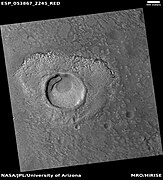示巴高地

示巴高地(Terra Sabaea)是火星上一處幅員遼闊的大區域,最寬處達到4700 公里(2900英里),其中心坐標位於2°N 42°E / 2°N 42°E處,其名稱自火星上一處經典反照率特徵,1979年,被國際天文聯合會正式批准接受。沙巴高地相當大,部分橫跨了阿拉伯區、大瑟提斯區、雅庇吉亞區、伊斯墨諾斯湖區和示巴灣區等五大區域。
冰川
[編輯]有些景觀看上去就像地球上從山谷中流出的冰川,部分呈現出空蕩蕩的外觀,就像所有的冰都已消失,只剩下了冰磧—冰川攜帶的泥土和碎屑。由於大部分冰已消失,使得中間被掏空[1]。這些假想的高山冰川被稱為類冰川形態(GLF)或類冰川流(GLF)[2]。類冰川形態是一條出現較晚的術語,可能更準確,因為無法確定該結構目前是否還在移動[3] 。有時在文獻中看到的另一條更通用的術語稱之為粘性流特徵[3]。
表面上的各種其他特徵也被解釋為與流動冰直接相關,例如銳蝕地形[4]、線狀谷底沉積[5][6]、同心坑沉積[7][8] 以及皺嶺等[9],在中緯度和極地區圖像中看到的各種表面紋理也被認為與冰川中的冰升華有關[8][10]。
下面的圖片顯示了一些被認為是冰川的特徵,其中有一些可能仍含有冰,而在其他地區,冰可能已基本消失了。由於在僅數米厚的碎屑下就可能有水冰,因此,這些地方可為未來定居者提供水源。
-
陸地衛星8號顯示的地球北極圈象腳冰川的羅默湖(Romer Lake),該照片顯示的數條冰川,其形狀與火星上許多被認為也是冰川的地貌相同。
-
背景相機拍攝的伊斯墨諾斯湖區被數處冰川侵蝕的桌山。在接下來的兩幅高解像度成像科學設備照片中,可更詳細地觀看到其中的冰川。
-
放大的前一幅圖像矩形區,在地球上,這種山脊被稱為高山冰川尾磧。
-
HiWish計劃下高解像度成像科學設備顯示的線狀谷底沉積(LVF)特寫,註:這是先前背景相機圖像的放大版。
-
HiWish計劃下高解像度成像科學設備顯示的伊斯墨諾斯湖區線狀谷底沉積彩色近景圖。
沙丘
[編輯]當有穩定的風向和足夠多的沙子時,就會產生出完美的沙丘條件,形成一座新月沙丘。新月沙丘的迎風側一般為緩坡,而背風側則是更陡峭的斜坡,那裏經常會形成沙堆角或凹口[11],整片沙丘似乎隨風而動。觀察火星上的沙丘可告訴我們那裏的風向及風力強度。如果定期拍攝照片,則可能會看到沙丘的變化或沙丘表面的漣漪。火星上的沙丘通常呈深色,因為它們是由普通的火山玄武岩所形成。在乾燥環境下,玄武岩中的深色礦物,如橄欖石和輝石,不會像在地球上那樣會分解。雖然不常見,但在夏威夷也發現了一些黑色的沙子,那裏也有許多火山都噴出玄武岩。新月沙丘是一條俄羅斯術語,因為這種類型的沙丘最早出現在突厥斯坦的沙漠地區[12]。火星上的一些風是在春季兩極乾冰被加熱時產生的,那時固態的二氧化碳(乾冰)升華或直接變成氣體並高速沖走。 火星每年大氣層中有30% 的二氧化碳會凍結並覆蓋在處於冬季的極地,因此極有可能出現強風[13]。在示巴高地部分地區出現的沙丘如下圖所示。
-
HiWish計劃下高解像度成像科學設備顯示的舍貝勒隕擊坑中的沙丘。
-
HiWish計劃下高解像度成像科學設備顯示的沙丘和隕石坑,有些沙丘為新月形沙丘。
示巴高地的侵蝕特徵
[編輯]-
火星軌道器相機公共目標計劃下火星全球探勘者號拍攝的大瑟提斯區被侵蝕的桌山,要步行穿越這一特徵是很困難的。
-
HiWish計劃下高解像度成像科學設備拍攝的隕石坑沉積物特寫照片,顯示了撞擊隕石坑和塌陷形成的深坑。
同心坑沉積是一種地貌,其中撞擊坑內大部分地表都覆蓋着大量的平行山脊 [14],一般在火星中緯度地區較為常見[15][16],普遍認為這是由冰川運動所引起[17][18]。
-
HiWish計劃下高解像度成像科學設備顯示的同心坑沉積發育良好的凹陷。
-
HiWish計劃下高解像度成像科學設備拍攝的含有同心坑沉積的隕坑特寫照片,可看到坑內地表上分佈有深坑的裂縫。
隕石坑中的岩層
[編輯]斜坡上的岩層,尤其是隕石坑坡壁上的岩層,被認為是一種曾廣泛分佈的物質殘跡,訪物質大部分已經被侵蝕掉了[19]。
-
HiWish計劃下高解像度成像科學設備顯示的隕坑中的岩層,該區域可能被這些岩層覆蓋,除隕坑內受保護的部分外,其餘部分的岩層現在都已被侵蝕了。
-
HiWish計劃下高解像度成像科學設備顯示的隕坑中的岩層。
-
HiWish計劃下高解像度成像科學設備顯示的隕坑中的岩層。
-
HiWish計劃下高解像度成像科學設備顯示的隕坑中各層近景,註:這是前一幅圖像的放大版。
岩層
[編輯]火星上的許多地方都有分層重疊的岩石,岩石可通過火山、風或水等多種作用方式形成岩層[20],地下水也可能參與了某些地方地層的形成。
-
HiWish計劃下高解像度成像科學設備顯示的弗拉馬利翁隕擊坑中的岩層。
-
HiWish計劃下高解像度成像科學設備顯示的岩層.
-
HiWish計劃下高解像度成像科學設備顯示的岩層寬景圖
-
HiWish計劃下高解像度成像科學設備顯示的岩層近景圖
-
HiWish計劃下高解像度成像科學設備顯示的岩層近景,一條突脊垂直穿過了岩層。
-
HiWish計劃下高解像度成像科學設備顯示的岩層近景,圖片部分彩色,一道突脊垂直穿過了各岩層。
線性脊狀網
[編輯]線性脊狀網在火星各地的隕石坑內外都能找到[21],這些突脊通常以格子狀相交的直線形式出現,它們長數百米,高幾十米,寬數米。據認為,撞擊會在地表形成裂縫,這些裂縫後來又充當了流體通道,液體使這些結構膠結凝固。隨着時間的推移,周圍的材料被侵蝕掉,從而留下堅硬的突脊。 由於山脊出現在有粘土的地方,這些地層可以作為粘土的標誌,而粘土的形成需要水[22][23][24],這裏的水可能提供了支撐。
-
HiWish計劃高解像度成像科學設備顯示的脊狀網,它們可以通過各種方式形成。
-
HiWish計劃高解像度成像科學設備顯示的彩色脊線近景圖。
-
HiWish計劃高解像度成像科學設備顯示的與前兩幅圖像相同位置的更多脊線
-
HiWish計劃高解像度成像科學設備顯示的線性脊狀網。
-
HiWish計劃高解像度成像科學設備顯示的前一幅線性脊狀網圖像的彩色特寫。
-
HiWish計劃高解像度成像科學設備顯示的與前兩幅圖像位於同一位置的更多線性脊狀網。
-
HiWish計劃高解像度成像科學設備顯示的線性脊狀網,該圖像的部分區域將在後面的照片中被放大。
-
HiWish計劃高解像度成像科學設備顯示的線性脊狀網近景,這是前一幅圖像的放大版。
-
CHiWish計劃高解像度成像科學設備顯示的線性脊狀網近景,這是先前圖像的放大版,方框顯示了足球場大小的區域。
-
HiWish計劃高解像度成像科學設備顯示的線性脊狀網近景,這是先前圖像的放大版。
-
HiWish計劃高解像度成像科學設備顯示的突脊近景,這是之前圖像的放大版,圖像中有一座顯示出岩層的小桌山。
-
HiWish計劃高解像度成像科學設備顯示的彩色線性脊狀網近景,這是之前圖像的放大版。
其它特徵
[編輯]-
背景相機拍攝的桌山寬景照片,顯示了舌狀岩屑坡(LDA)和線狀谷底沉積(LVF)),據認為這兩者都是被岩屑覆蓋的冰川。
-
HiWish計劃高解像度成像科學設備顯示的腦紋地形。
-
上一張桌山背景相機中舌狀岩屑坡的特寫,圖中顯示了更常見的細胞開放型腦地形和細胞封閉型腦紋地形,開放型細胞被認為裏面含有冰核。
-
HiWish計劃高解像度成像科學設備顯示的可能形成於富冰地面的撞擊坑。
-
HiWish計劃高解像度成像科學設備觀察到的可能形成於富冰地面上的撞擊坑,請注意噴出物似乎比周邊地貌更低。原因可能是熱噴射物導致了一些冰的消失,從而降低了噴射物的水平面。
火星交互地圖
[編輯]
 火星全球地形的交互式圖像地圖。將鼠標懸停在圖像上可查看 60 多個著名地理特徵的名稱,單擊可連結到它們。圖底顏色表示相對高度,根據來自美國宇航局火星全球探勘者號上火星軌道器激光高度計的數據。白色和棕色表示海拔最高(+12 至 +8 公里);其次是粉紅和紅色(+8 至 +3 公里);黃色為 0 公里;綠色和藍色是較低的高度(低至 -8 公里)。軸線是經緯度,極地已備註。
火星全球地形的交互式圖像地圖。將鼠標懸停在圖像上可查看 60 多個著名地理特徵的名稱,單擊可連結到它們。圖底顏色表示相對高度,根據來自美國宇航局火星全球探勘者號上火星軌道器激光高度計的數據。白色和棕色表示海拔最高(+12 至 +8 公里);其次是粉紅和紅色(+8 至 +3 公里);黃色為 0 公里;綠色和藍色是較低的高度(低至 -8 公里)。軸線是經緯度,極地已備註。另請查閱
[編輯]參引文獻
[編輯]- ^ Milliken, R., J. Mustard, D. Goldsby. 2003. Viscous flow features on the surface of Mars: Observations from high-resolution Mars Orbiter Camera (MOC) images. J. Geophys. Res. 108. doi:10.1029/2002JE002005.
- ^ Arfstrom, J and W. Hartmann. 2005. Martian flow features, moraine-like ridges, and gullies: Terrestrial analogs and interrelationships. Icarus 174, 321-335.
- ^ 3.0 3.1 Hubbard B., R. Milliken, J. Kargel, A. Limaye, C. Souness. 2011. Geomorphological characterisation and interpretation of a mid-latitude glacier-like form: Hellas Planitia, Mars Icarus 211, 330–346
- ^ Lucchitta, Baerbel K. "Ice and debris in the fretted terrain, Mars." Journal of Geophysical Research: Solid Earth (1978–2012) 89.S02 (1984): B409-B418.
- ^ G.A. Morgan, J.W. Head, D.R. Marchant Lineated valley fill (LVF) and lobate debris aprons (LDA) in the Deuteronilus Mensae northern dichotomy boundary region, Mars: Constraints on the extent, age and episodicity of Amazonian glacial events Icarus, 202 (2009), pp. 22–38
- ^ D.M.H. Baker, J.W. Head, D.R. Marchant Flow patterns of lobate debris aprons and lineated valley fill north of Ismeniae Fossae, Mars: Evidence for extensive mid-latitude glaciation in the Late Amazonian Icarus, 207 (2010), pp. 186–209
- ^ Milliken, R. E., J. F. Mustard, and D. L. Goldsby. "Viscous flow features on the surface of Mars: Observations from high-resolution Mars Orbiter Camera (MOC) images." Journal of Geophysical Research 108.E6 (2003): 5057.
- ^ 8.0 8.1 Levy, Joseph S., James W. Head, and David R. Marchant. "Concentric crater fill in Utopia Planitia: History and interaction between glacial 「brain terrain」 and periglacial mantle processes." Icarus 202.2 (2009): 462-476. Levy, Joseph S., James W. Head, and David R. Marchant. "Concentric crater fill in Utopia Planitia: History and interaction between glacial 「brain terrain」 and periglacial mantle processes." Icarus 202.2 (2009): 462-476.
- ^ J. Arfstrom, W.K. Hartmann Martian flow features, moraine-like ridges, and gullies: Terrestrial analogs and interrelationships Icarus, 174 (2005), pp. 321–335
- ^ Hubbard, Bryn, et al. "Geomorphological characterisation and interpretation of a mid-latitude glacier-like form: Hellas Planitia, Mars." Icarus 211.1 (2011): 330-346.
- ^ Pye, Kenneth; Haim Tsoar. Aeolian Sand and Sand Dunes. Springer. 2008: 138. ISBN 9783540859109.
- ^ Barchan - sand dune. britannica.com. [4 April 2018]. (原始內容存檔於2014-10-30).
- ^ Mellon, J. T.; Feldman, W. C.; Prettyman, T. H. The presence and stability of ground ice in the southern hemisphere of Mars. Icarus. 2003, 169 (2): 324–340. Bibcode:2004Icar..169..324M. doi:10.1016/j.icarus.2003.10.022.
- ^ 存档副本. [2021-08-17]. (原始內容存檔於2016-10-01).
- ^ Dickson, J. et al. 2009. Kilometer-thick ice accumulation and glaciation in the northern mid-latitudes of Mars: Evidence for crater-filling events in the Late Amazonian at the Phlegra Montes. Earth and Planetary Science Letters.
- ^ HiRISE - Concentric Crater Fill in the Northern Plains (PSP_001926_2185). hirise.lpl.arizona.edu. [4 April 2018]. (原始內容存檔於2020-08-01).
- ^ Head, J. et al. 2006. Extensive valley glacier deposits in the northern mid-latitudes of Mars: Evidence for late Amazonian obliquity-driven climate change. Earth Planet. Sci Lett: 241. 663-671.
- ^ Levy, J. et al. 2007.
- ^ Carr, M. 2001. Mars Global Surveyor observations of martian fretted terrain. J. Geophys. Res. 106, 23571-23593.
- ^ HiRISE | High Resolution Imaging Science Experiment. Hirise.lpl.arizona.edu?psp_008437_1750. [2012-08-04]. (原始內容存檔於2017-08-08).
- ^ Head, J., J. Mustard. 2006. Breccia dikes and crater-related faults in impact craters on Mars: Erosion and exposure on the floor of a crater 75 km in diameter at the dichotomy boundary, Meteorit. Planet Science: 41, 1675-1690.
- ^ Mangold et al. 2007. Mineralogy of the Nili Fossae region with OMEGA/Mars Express data: 2. Aqueous alteration of the crust. J. Geophys. Res., 112, doi:10.1029/2006JE002835.
- ^ Mustard et al., 2007. Mineralogy of the Nili Fossae region with OMEGA/Mars Express data: 1. Ancient impact melt in the Isidis Basin and implications for the transition from the Noachian to Hesperian, J. Geophys. Res., 112.
- ^ Mustard et al., 2009. Composition, Morphology, and Stratigraphy of Noachian Crust around the Isidis Basin, J. Geophys. Res., 114, doi:10.1029/2009JE003349.
閱讀推薦
[編輯]- Grotzinger, J. and R. Milliken (eds.). 2012. Sedimentary Geology of Mars. SEPM.
- Lorenz, R. 2014. The Dune Whisperers. The Planetary Report: 34, 1, 8-14
- Lorenz, R., J. Zimbelman. 2014. Dune Worlds: How Windblown Sand Shapes Planetary Landscapes. Springer Praxis Books / Geophysical Sciences.












































